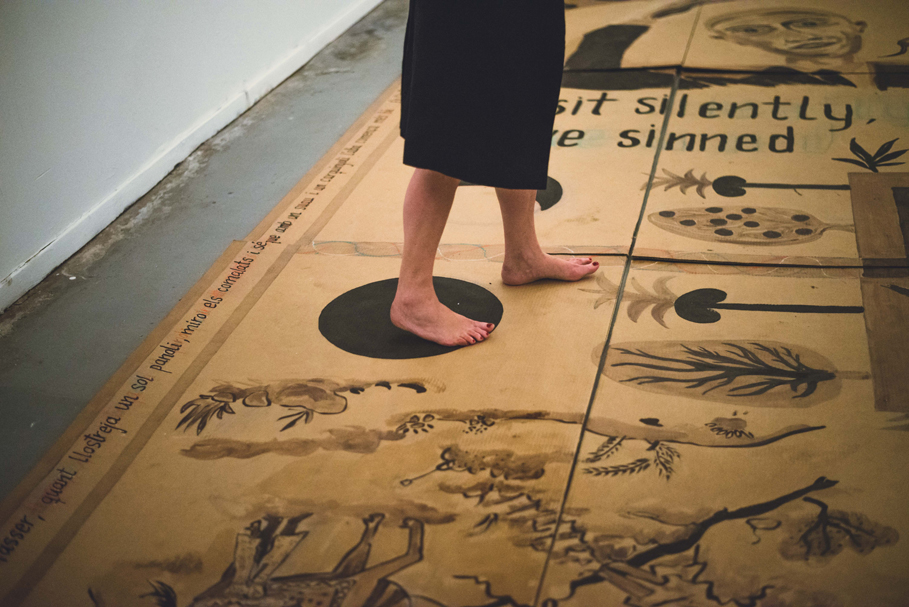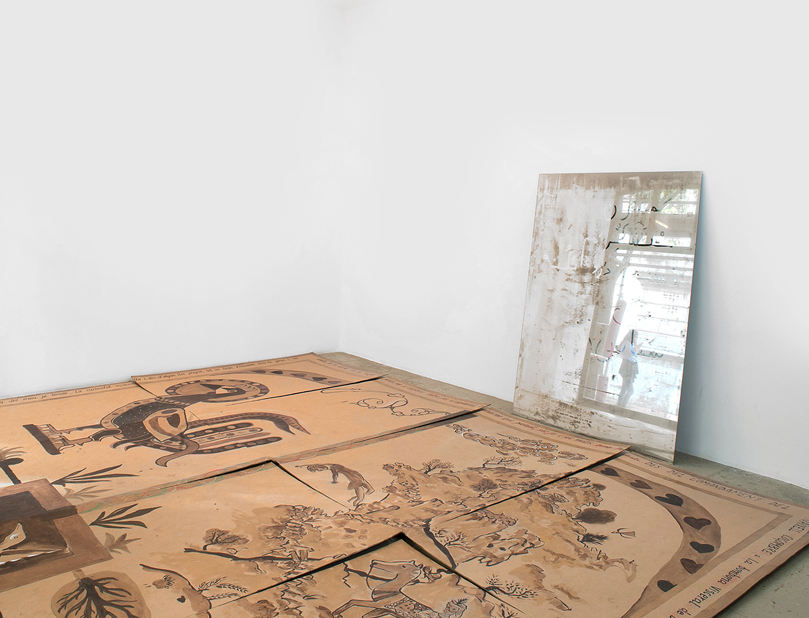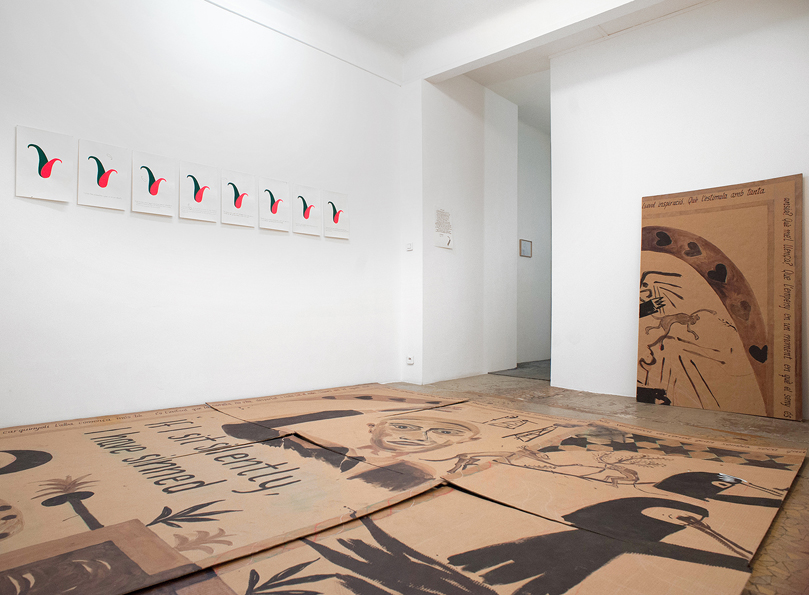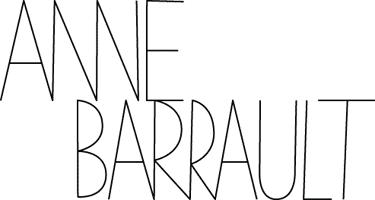Tere Recarens was born in 1967 in Arbùcies. Her woks have to do with moving, the turmoil it sometimes infers. Most
of them are answers to precise contexts: Tere Recarens, by choice or necessity, can be brought to react to a situation, she often tries to twist. Each answer is based on the attentive observation of the context and the customs, and often demands investigation over time. In this way, meeting other people is decisive; it can lead to new knowledge, induce any project, any research. Tere Recarens’art is like the video of this sailboat jostled by waves, but trying to keep its course, its quest (Adventure, 2008-2016). Tere Recarens has lived and worked in various countries. However, for her, travelling is not an end in itself: it is the means, among others, to go on searching. For her exhibition at gallery Anne Barrault, she has chosen to show two works resulting from several stays in Iran and her studying the history and culture of this country: Baharestan Carpet (2017-2018), a cardboard carpet, and Spark (2015-2017), patterns on paper.
I fly like the birds outside my window, and then four hours later, they fly away, and I leave and visit the city.
(posted from Teheran, February 2018)
A short time after settling in Berlin – where she has now been living for several years, Tere Recarens made a short
film in which, during a minute’s parachute free fall she sweeps away the clouds in order to see the outlines of the city a little more clearly (Besenrein, 2003). For her, this video means “the discovery of a new culture”. It is also escaping “gravity” for a short while, being confronted with it definitely. Besenrein means “immaculate”.
BAHARESTAN CARPET is a cardboard carpet. “Baharestan”, meaning “where spring is” is the most common
name in Teheran for the legendary carpet, decking Ctesiphon palace, under Khosro 1st (531-579) in Sassanid time.
It is known through descriptions, which have inspired many artists. Baharestan Carpet was presented in Barcelona in
2017. In Paris , it is shown with new graphic productions at the back. Its pattern is a garden divided into four parts with three themes: Persian literature, mythology, political Iranian history and women’s place. Its iconography and its style are based on different visual sources. The parts are organized around a central pond filled with birds.
The transcription of Josep Pedrals’ “spontaneous” poem runs around the carpet. This poem has been imagined from
words collected from Catalan intellectuals.
A mythical bird is represented in one of the parts: the Simorgh. This ancient symbol fills the birds song, Farid od-dîn ‘Attâr’s spiritual epic, of 4724 distiches (1158-1221). The poet’s name means perfumer, apothecary, the one who “heals souls by guiding them thanks to words and tale 1”. One day the birds of the world get together and decide to go and look for the king of the birds. The translators have always thought, up to now, that it was a male figure, because it symbolizes God. After reading the text and the contest, Simorgh appears to be actually the female face of the Divinity such as it expresses itself to men in all its splendor. A hoopoe, a messenger in the story of King Salomon, leads the journey of the birds. Siborgh nests up on Qâf, the cosmic mountain, and to reach her place, they will all have to fly over seven valleys, each of them being a spiritual step. As they are growing reluctant to carry on this journey to the end, the hoopoe tells them many stories to encourage them , and teach them how to abandon their “vain attachments”.
Nearly all the birds die or give up the search, and only thirty “ bird-souls” reach the goal. By playing on words -“thirty birds” is said “ sî-morg”- ‘Attâr tells us that the seven valleys mean a personal quest, which is not linear. The only way to get to the invisible and inexpressible Siborgh is to plunge “into the fire of its presence”: “They were overwhelmed, this time, for ever/ And at last the shadow disappeared into the sun!”2
Simorgh also appears in The Book of the kings by Abol –Qâsen Ferdowsî (+ 1020), an inspiration for ‘Attâr. She is
obviously ambivalent. She teaches Zâl, a young “white haired” warrior and the son of the king of Sistân , she had
taken in, how to do a Caesarean section on Rudâbeh, his wife. Zâl saves the mother and the child. Rostan, the
legendary Persian hero, was born.
SPARK is a set of eight impressions on paper, a study of boteh jegheh, better known as boteh motifs or paisley.
“Spark” combines three successive printing processes. This long gestation in elaborating the work is due to the quest of the history of this motif. The boteh jegheh is full of political, religious or spiritual meanings. The solid colored motifs faithfully replicated on each piece of paper are silk-screen printed. The boteh jegheh story unfolds as the eight impressions go: the sentences have been lithographed. So, the neat and simple screen-printed motifs are enriched with a new meaning as the story develops. “Spark”, the boteh jegheh motif, printed by hot stamping, travels through the shapes and the story. It represents search and progress.
“Simorgh soars up, and at the same time does not move; she flies without covering any distance; she comes nearer,
however has travelled no space. Know that all colors come from Simorgh, but Simorgh herself has no color. Her nest
is in the East, but her place in the West is not empty. She concerns everyone, but she is empty of all. What we know comes from this Simorgh ‘s incantation.”3
Frédéric Oyharçabal
April 2018
1 Leili Anvar, “L’envol”, in Farid od-dîn ‘Attâr, le cantique des oiseaux, Diane de Sellier, publisher, Paris, 2014, pp. 13-25.
2 Distich 4286.
3 Shahâ oddin Yahyâ Sohravardî, L’Archange empourpré (the crimson Archangel). Fifteen mythical treatises and stories, translated from Persian and Arabic,Henry Corbin, translator. Fayard, Paris, 1976.

détail Baharestan Carpet, 2017-2018
carton, gomme arabique, pigments, encre invisible, 720 x 440 cm
© Ana Agraz
Conversation with Tere Recarens
Frédéric Oyharçabal
Your first visit in Mali was motivated by the desire to discover the meaning of the word ‘tere’ among the
Bamanan; a word you discovered during a meeting with a certain Lunettes Rouges. What would your
definition of this concept be today?
That they are born with tere, which is equivalent to our concept of destiny.
Does tere have an influence in the way you work?
I learned to recognize when it´s not the right time for it. When the energy is not good, and so I feel and
remain quiet.
To me, Mes derniers calsons, 1997 [My Last Panties] is a self-portrait. In this photograph where you show us
your “behind”, you are wearing panties worn out in several places. It is a piece from your early work. What
meaning do you attach to it today?
The more you persevere, the more you find yourself.
During your research voyages, you have at times experienced challenging situations which you have strived
hard to flip and turn to you, like a glove. From Mashhad to Mashhad (2015) is the transformation of the
negative effects of an event – a plane crash – for you and those around you, into something positive. It is a
set of drawings that you made during this journey. You wrote in Farsi on each one of the drawings the
following question “What do you think is the most important thing in life?” and you distributed them to the
passengers. Moreover, when you make me part of a difficult experience, or disappointment, sometimes you
conclude that: “Finally, I am lucky”.
Yes, that’s it! In this specific case, creativity helps. And then the joy of living a real ‘déjà vu’!
After your stay in Inner Mongolia in 2008, you published a facsimile of a pocket-book filled with drawings you
made to communicate with locals. Do you feel that drawing is a language as any other?
Yes, internationally.
Glory (2007) is a cover, Fucking Glory (2007) a long wall hanging. These two pieces consist of scarves of
various soccer teams, which have been sewn together along the side edges. Fucking Damned Glory (2008) is
a hanging in the same spirit but it is you who designed the scarves and, on each of them, you drew objects or
situations framed in their equivalent in Chinese. These three works form a trilogy which is derived from the
same structural motif. You continued this quest in Mali, with the design of your own message fabric that you
proposed in exchange for other fabrics – which resulted in different works, then in Iran by studying Farsi and
researching a motif, the ‘Boteh Jegheh’.
The ‘Boteh Jegheh’ is known in the West as ‘Paisley’. It is a very ancient motif of the times of the Medes.
You present a large cardboard carpet inspired by an ancient carpet which disappeared and is only known about through descriptions.
What kind of a carpet is it?
It is The Winter Carpet or The Spring of Khosro (10). I have always been interested in this period of history:
Persian art before the Arab conquest. This carpet was in the palace of Ctesiphon at the time of the
Sassanid Empire. It was so beautiful that the Arabs were afraid of falling in love with Persian culture and
also it was very heavy. So they cut it into several pieces and distributed it as loot.
Here are some verses from the poem ‘Chants entre l’âme et l’époux’ [Songs Between the Soul and the
Spouse], Cantique Spirituel [Spiritual Song] – manuscript of Sanlúcar – by Jean de la Croix (11):
Buscando mis amores,
iré por esos montes y riberas ;
ni cogeré las flores,
ni tereré las fièras,
y pasaré los fuertes y fronteras.
Seeking my loves,
I will go by these mountains and shores,
Will not pick the flowers
Nor fear the wild beasts,
And will pass the forts and the borders.
All the beginnings of love seemed easy – Hafez
Baharestan Carpet (2017-2018) is a cardboard carpet. Why did you choose this material?
It is not expensive, and you walk on it as carefully as on a real carpet. When it will start to wear out, I
should like to hang it on the wall.
What does Tere Zelzeleh mean?
In Farsi, it is Terremoto.
You have signed this carpet with a Farsi pun inside a “boteh jegheh” which can be translated into “the bo
tere road”. With Spark; (2015-2017), a set of eight silkscreen prints, you tell us the story of this motif also
called paisley motif. You write that in the Sasanian period almonds were thought sacred, and became
ornamental patterns. On the garments of kings and senior officials, their names appeared inside an almond
shape. The same shape is seen from one silkscreen print to the other. You have printed it by hot stamping, a
process often used for signatures, seals. The shape is empty, without anything or any name inside. What
does it represent?
A spark: like a life.
What does Josep Pedrals’ Catalan poem you have recopied around the Baharestan Carpet call up?
The poem means my identity. Its vocabulary is rich, because each of some thirty intellectual Catalans has
given a word.
In 2009, you drew a somehow incomplete map of the world. We can see Europe, Africa, America, West Asia
and a small bit of Australia. Each, except for Australia, is associated with an element. For America, fire; Africa:
earth; Europe: water; West Asia: air. Can you explain your choice for each of them?
It is how I felt when I was there. As for Australia, where my work has been shown, it is ether.
ETHEREAL (1999) is a room suspended by cables, at a low height. It rocks as soon you enter it. Inside, you
show a video: monkeys, in a park, handle flags on which is written “HAL” – the name of Antwerp exhibition
hall). The title of the installation is the interweaving of two names (“TERE” and “HAL”) turned into
“ETHEREAL”. This English word means “ethereal”, that’s is to say above earthly things.
It is only because I was just back to Europe, in love with a year spent in New York, and I landed “by grace”
in Belgium – I had a ticket for Barcelona.
We see monkeys again in Baharestan Carpet in which they participate in the representation of women
fighting each other. Can you explain this scene?
For some time women have been fighting for their freedom, but other women fight them. These are the
diseases of civilization.
What does the presence of monks mean then in Baharestan Carpet and in ETHEREAL?
In the carpet, the monkeys represent what is irrational. In the video, they do ply extremely well, and the
motion of the suspended monitor is different of the motion of the room, which produces an “ETHEREAL”
effect.
Beside the fight scene, you have drawn Mohammad Mossadegh, and you have written this sentence: “IF I
SEAT SILENTLY, I HAVE SINNED”. What does it mean?
They are Mossadegh’s words. He proclaimed the nationalization of Iranian oil in 1951, and was
overthrown by the United States and Great Britain in 1953 (13); Mossadegh’s ideas are still current. There is
an Iranian proverb, which describes the situation in the country very well: “ A potter man drinks water
from a broken jar”.
You have also drawn Simorgh. What is it for you?
One day Abu Ali gave me the book the Conference of the birds (14). I always have this book with me. And
then, I threw myself into the flame.
11. From the name of the sovereign Khosro 1st (531-579).
12. Jean de La Croix, Poésies complètes, Librairie Séguier/Obsidiane, Paris, 1988, p.23.
13. Mohammad Mossadegh (1882-1967), a statesman, strove, after the Second World War, for democracy, political and economic
independence in Iran. Mossadegh embodied the rejection of foreign interfering and the opposition to colonial
14. Simorgh is a legendary bird in Persian mythology, the subject of a mystic quest in the Song of the birds by Farid od-dîn’Attâr (1158-1221), also known with the title The Conference of the birds.



